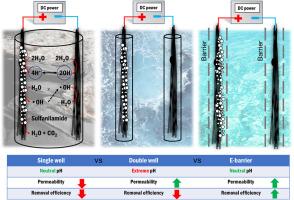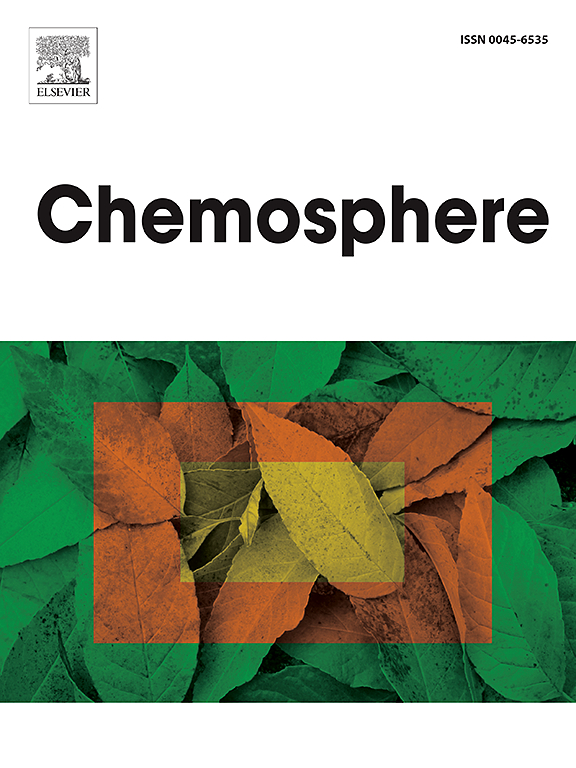评估用于去除磺胺的沙盒系统中的电极配置:一项试点研究。
IF 8.1
2区 环境科学与生态学
Q1 ENVIRONMENTAL SCIENCES
引用次数: 0
摘要
电化学氧化已成为一种有效而直接的地下水修复技术。虽然最近的研究对电流、电解质成分和电极材料等参数进行了调查,但大多数研究都是使用小规模的间歇式或流动式反应器进行的,因此限制了其在实际条件下的适用性。在本研究中,采用了中试规模的沙箱反应器来模拟真实的地下水条件,并评估模型有机污染物磺胺的去除情况。对各种电极配置进行了系统评估,以确定影响污染物去除效率的关键操作参数,为地下水处理的实际应用提供启示。本研究提出了三种配置,包括阳极和阴极的单井、阳极和阴极分离的双井以及电极分别安装在透水屏障内的电子屏障。单孔的去除效率最低(60%),因为阴极反应抑制了阳极氧化。阳极和阴极分离的双井可达到 80% 的去除率。不过,污水的 pH 值最高可达 13.2,会对地下水造成不利影响。与此同时,电子屏障不仅实现了完全去除,而且在 30 天内保持了 7.0 的中性 pH 值。根据其去除效率(100%),电子屏障被证明是最有效的配置,同时还能产生 pH 值为中性的污水。电子屏障最有效的能耗为 1.54 kWh/m3,而其他配置的能耗分别为 5.40 kWh/m3 和 22.18 kWh/m3。从去除效率和在地下水中的实际应用来看,电子屏障都被认为是一种非常合理的配置。本文章由计算机程序翻译,如有差异,请以英文原文为准。

Assessing the electrode configuration in a sandbox system for the removal of sulfanilamide: A pilot study
Electrochemical oxidation has emerged as an effective and straightforward technology for groundwater remediation. While recent studies have investigated parameters such as current, electrolyte composition, and electrode materials, most have been conducted using small-scale batch or flow reactors, limiting their applicability to real-world conditions. In this study, a pilot-scale sandbox reactor was employed to simulate realistic groundwater conditions and assess the removal of sulfanilamide, a model organic contaminant. Various electrode configurations were systematically evaluated to identify the key operational parameters influencing pollutant removal efficiency, providing insights for practical applications in groundwater treatment. This study proposes three configurations, including a single well with the anode and cathode, a double well with the separated anode and cathode, and an e-barrier with electrodes separately mounted inside a permeable barrier. Single well had the lowest removal efficiency (60%) because cathodic reaction inhibited the anodic oxidation. A double well with a separate anode and cathode can achieve 80% removal efficiency. However, effluent pH can reach up to 13.2, which can adversely impact groundwater. Meanwhile, the e-barrier not only achieved complete removal, but also maintained a neutral pH of 7.0 over 30 days. The e-barriers proved to be the most effective configuration based on their removal efficiency (100%) while yielding an effluent with neutral pH. The energy consumption of the e-barrier was most effective at 1.54 kWh/m3, while the other configurations were 5.40 and 22.18 kWh/m3. E-barriers are deemed a very reasonable configuration, both in terms of removal efficiency and practical application in groundwater.
求助全文
通过发布文献求助,成功后即可免费获取论文全文。
去求助
来源期刊

Chemosphere
环境科学-环境科学
CiteScore
15.80
自引率
8.00%
发文量
4975
审稿时长
3.4 months
期刊介绍:
Chemosphere, being an international multidisciplinary journal, is dedicated to publishing original communications and review articles on chemicals in the environment. The scope covers a wide range of topics, including the identification, quantification, behavior, fate, toxicology, treatment, and remediation of chemicals in the bio-, hydro-, litho-, and atmosphere, ensuring the broad dissemination of research in this field.
 求助内容:
求助内容: 应助结果提醒方式:
应助结果提醒方式:


